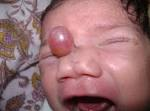
Tumor neurogénico benigno intra o extranasal con cavidad ependimaria llena de líquido cefalorraquídeo. Es una verdadera hernia cerebral por defectos óseos en la lámina cribosa etmoidal. Se han de diferenciar de los gliomas. Son de interés para el ORL los nasofrontales, nasoetmoidales y nasoorbitales.
<(A): Enzephalozele: ist ein Defekt, der durch eine Hernierung von Hirngewebe und Membranen durch eine Öffnung im Schädel gekennzeichnet ist. Sie werden nach ihrer Lokalisation klassifiziert. Okzipitale Enzephalozelen (die am Hinterkopf entstehen, wo der Kopf auf den Hals trifft) kommen in 75% der Fälle vor, parietale Enzephalozelen in 10% und anteriore Enzephalozelen (die vom Nasenansatz ausgehen) in 15%. Anterioposteriore Enzephalozelen haben eine schlechtere Prognose.
<(F): Encéphalocèle: dysraphia crânienne avec hernie, sur la ligne médiane, d'un sac méningé contenant du liquide céphalorachidien et du tissu nerveux encéphalique. L'encéphalocèle peut être:superficielle visible, occipitale, syncipitale ou frontale ; dans la profondeur de la face (frontonasale) entraînant soit une schizoprosopie, soit une hypertélorisme.
<(Ing): Encephalocele: is a defect characterized by the herniation of brain tissue and membranes through an opening in the cranium. Are classified according to their location. Occipital (arising at the back of the head where the head meets the neck) encephaloceles occur in 75% of cases, parietal encephaloceles in 10%, and anterior encephaloceles (arising from the base of the nose) in 15%. Anterioposterior encephaloceles have a poorer prognosis.
FUENTES DE INFORMACIÓN BIOMÉDICA:
IMÁGENES:
- ATLAS DE NEUROLOGÍA. <(E)
TÉRMINOS RELACIONADOS:
